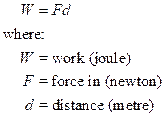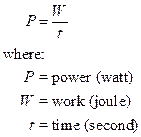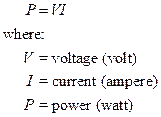Without energy, nothing could happen. Whenever you see movement, sound, heat or light, there is energy. The SI unit of energy is the joule, and the unit symbol is 'J'. The joule is a very small quantity of energy, so more common units are the kilojoule (kJ) and the megajoule (MJ).
Energy can exist in many forms, and we can convert energy from one form to another. Consider the following manifestations of energy:
The Law of Conservation of Energy says that energy is 'conserved'. This means that energy cannot be created or destroyed, but can be changed from one form to another. Technology has many examples of conversion of energy, including:
Notes:
1. The conservation law has had to be slightly modified in modern times, because we now know that mass can be converted into energy and vice versa. Small amounts of mass are converted to enormous amounts of energy in nuclear power stations and nuclear weapons.
2. All energy eventually ends up as heat, which is dissipated into the environment and cannot be recovered. So while energy cannot be ‘destroyed’, it cannot always be converted into a useful form for our use. In addition, our machines cannot use all the energy present in an energy source, and there will always be some wastage or loss.
The concept of work gives us a very straightforward definition to determine an amount of energy. Work is done when a force moves a body through a distance. The work done is given by:
![]()
or in symbols:

Work has the same units as energy, and we can say that energy is the capacity to ‘do work’. Work is signified by the letter 'W'.
Note that 'work' is a scientific term with a very specific meaning — it does not mean people doing work in the everyday sense of the term. However, when doing physical work, people are also doing some amount of work in this technical sense.
Power is the rate of doing work, or equivalently, the rate of producing or expending energy. The symbol for power is P, and the unit is the watt (W). When energy is consumed at the rate of one joule per second, the power is one watt.
Power can be illustrated by the fact that it may take several hours to dig a trench with hand tools, but an engine-driven backhoe could do the same job in a few minutes. We say the machine is more powerful, because it delivers much more energy in the same period of time.
As power is the rate of doing work we can say that power is work per unit time, or in symbols:

Don’t confuse the ‘W’ used here for watt with the ‘W’ used for ‘work’. When dealing with small or large quantities we make use of the milliwatt, the kilowatt, and the megawatt:
|
If you have Hampson, read the ‘Power, work and energy’ section on page 5 through to page 12, taking note how the equations are used. |
When electric current flows through a resistor, electrical energy is converted to heat and leaves the circuit (it is ‘expended’ use ‘used’). For example, current flowing through a lamp causes it to emit light and heat energy. The energy required to light the bulb is provided by the flow of charges through the lamp.
The rate at which energy is delivered to a circuit is the power.
Another example is the electric motor. The energy delivered to an electric motor is converted to useful mechanical work. A motor that is efficiently converting energy to work behaves like a resistor.
The power of an appliance is one of the most important parameters to specify. For example, to boil a litre of water using a 750 W electric jug might take three minutes. To boil the same amount of water using a 1500 W electric jug would take about half that time. Likewise, an air conditioner with insufficient power may fail to maintain a room at a comfortable temperature.
The power rating of an electrical appliance is important because it determines:
Information relating to the electrical characteristics of an appliance is stamped on a manufacturer’s nameplate which is attached to the appliance. The information always includes the:

Figure 1: A typical electrical nameplate
The nameplate in Figure 1 belongs to an electrical stapling machine. The information on it shows that:
Electric light globes are a common example. A globe rated at 240 V, 100 W is brighter and costs more to operate than a 240 V, 40 W lamp.
Lamp wattages refer to the input power. However, this is not always the case. The power rating of electrical equipment may specify either:
The input power of an appliance is usually quoted when it is not practical to quote the output power. Common examples of such equipment are a bread toaster, a hot-water service, a welding machine or a lamp. In these examples electrical energy is being converted to heat, and this represents the ‘final’ state of the energy – the energy will not be converted to another form. It therefore makes sense to simply quote the power used by the device.
For industrial equipment such as transformers or motors, the output power is quoted, because this figure is required to make use of the device For example, it is important to know that mechanical output power that is provided by a motor in order to select a motor for a particular job. Note that where the output power is quoted, the electrical power that is actually used will be greater, because of the losses within the device.
|
Activity 1 |
1 What is the unit of electric power?
2 What can we learn from the power rating of an electrical appliance?
3 What information is usually given on an appliance nameplate?
4 If work of 100 J is used to move a body a certain distance in 0.25 s, what power would be required?
5 What is the relationship between a watt and a milliwatt?
6 Define power.
7 What work is done if a force of 20 N moves a body a distance of 5 m?
Check your answers with those given at the end of the section.
In a resistive circuit, electrical power is determined from the equation:

To make sense of this equation, we can compare the electrical situation to a water pump that is lifting water uphill. The height through which the water is lifted is similar to the circuit voltage. The flow rate of water is similar to the current. But the power expended depends upon both the amount of liquid pumped, and the height.

Source: http://lrr.cli.det.nsw.edu.au/LRRDownloads/3659/1/3659.doc
Web site to visit: http://lrr.cli.det.nsw.edu.au
Author of the text: indicated on the source document of the above text
If you are the author of the text above and you not agree to share your knowledge for teaching, research, scholarship (for fair use as indicated in the United States copyrigh low) please send us an e-mail and we will remove your text quickly. Fair use is a limitation and exception to the exclusive right granted by copyright law to the author of a creative work. In United States copyright law, fair use is a doctrine that permits limited use of copyrighted material without acquiring permission from the rights holders. Examples of fair use include commentary, search engines, criticism, news reporting, research, teaching, library archiving and scholarship. It provides for the legal, unlicensed citation or incorporation of copyrighted material in another author's work under a four-factor balancing test. (source: http://en.wikipedia.org/wiki/Fair_use)
The information of medicine and health contained in the site are of a general nature and purpose which is purely informative and for this reason may not replace in any case, the council of a doctor or a qualified entity legally to the profession.
The texts are the property of their respective authors and we thank them for giving us the opportunity to share for free to students, teachers and users of the Web their texts will used only for illustrative educational and scientific purposes only.
All the information in our site are given for nonprofit educational purposes